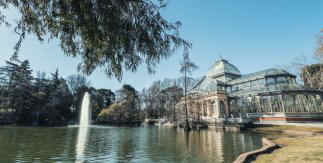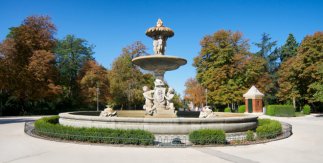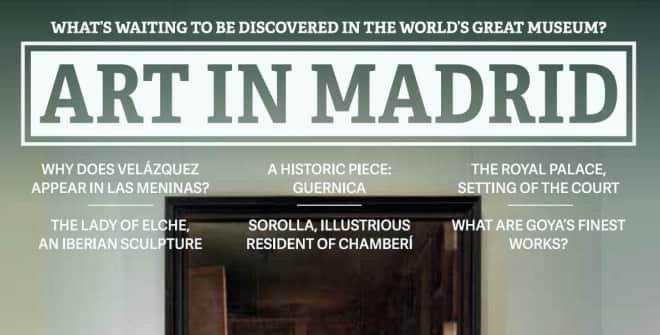Landscape of Light. Paseo del Prado and El Retiro Park
Paseo del Prado and El Retiro Park. Landscape of Arts and Sciences. New UNESCO World Heritage Site
The city of Madrid now forms part of UNESCO’s World Heritage list. Following Spain’s submission in 2019 of its nomination 'Paseo del Prado and El Retiro Park, Landscape of Arts and Science', UNESCO has now granted world heritage status to Madrid’s Paseo del Prado and El Retiro Park. In this extraordinary site that boasts “outstanding universal value” culture, science and nature have coalesced since the mid 16th century. The Landscape of Light is the first site in the city of Madrid to have been granted World Heritage status, and the fifth in the Region of Madrid which is home to El Escorial Monastery, Alcalá de Henare’s old town, Aranjuez and the Hayedo de Montejo.
Paseo del Prado was the first of Europe’s tree-lined urban promenades. Citizens began to use it in the 15th century as a place of recreation, and Philip II set about remodelling and beautifying it with trees and fountains. In the late 18th century, during the reign of Charles III, this urban renewal turned into a model that had a particularly strong influence in Latin America, giving rise to several notable projects on the other side of the Atlantic.
A new conception of the urban space emerged, an improvement based on a complex project with markedly social elements that included an innovative and decisive factor that made it unique in its era: the creation of an area devoted to research and science via a group of buildings and facilities of a scientific nature: the Natural History Cabinet - now the Prado Museum -, the Academy of Science, the Royal Botanical Gardens and the Royal Observatory. It was a major project with the aim of public dissemination, instruction and teaching of science, which would beautify the city at the same time.

The Landscape of Light, granted World Heritage Site status on 25 July 2021 in the Chinese city of Fuzhou, includes Paseo del Prado, from Plaza de Cibeles to Plaza de Atocha, the whole of El Retiro Park and the neighbourhood of Los Jerónimos.
The site contains an abundance of institutions that are exceptional for their sheer number as well as their diversity. It is home to Cibeles Palace, the current seat of Madrid City Council, the Bank of Spain, Casa de América, the Headquarters of the Spanish Army (Buenavista Palace), the Thyssen-Bornemisza Museum, the Congress of Deputies, the Westin Palace and Mandarin Oriental Ritz hotels, the Madrid Stock Exchange, the Headquarters of the Spanish Navy, the Naval Museum, the Prado Museum, the National Museum of Decorative Arts, the Royal Spanish Academy, the Church of San Jerónimo el Real, the Royal Botanical Gardens, the Royal Observatory, the National Museum of Anthropology, the Ministry of Agriculture, Fisheries, Food and the Environment, the Ministry of Health, Social Services and Equality, Moyano Hill (Cuesta de Moyano), CaixaForum and the Reina Sofía Museum, among other institutions.
It also boasts a number of famous monuments, such as Puerta de Alcalá gate, the Cibeles, Apolo and Neptuno (Cybele, Apollo and Neptune) fountains, the Alcachofa (Artichoke) Fountain, the “Obelisk”, or Monument to the Fallen, and the Monument to Alfonso XII at the lake in El Retiro Park. It is home to over 21 properties and objects declared to be of cultural interest (“Bienes de Interés Cultural”), and many of the holdings and collections contained therein are of global importance, such as the Royal Academy, works by Goya, Velázquez and Picasso, the collections of prints and archives at the Royal Botanical Gardens and the Herschel telescope.
Visit the bid's official website
The Paisaje de la Luz. Paseo del Prado and Buen Retiro brochure
OVER 21 SITES DECLARED ASSESTS OF CULTURAL INTEREST
Step away from the hustle and bustle of the city and spend a few hours relaxing in one of Madrileños' favourite spots, a UNESCO World Heritage Site.
One of the world’s leading art galleries boasting works by Velázquez, Goya, El Greco, Titian, Rubens and Hieronymus Bosch, among others.
A botanic garden in the city centre with a selection of more than 5,000 species of plants. Open every day except Christmas and New Year's Day.
The Royal Observatory of Madrid, founded by Charles III is a museum of astronomy dating back to the 17th century.
The cloister can be seen in the “Moneo Cube” in the Prado Museum, part of the Art Walk.
Built in 1637 and situated beside El Retiro Park, this former ballroom houses the Prado Museum library and study centre.
A total of 30,000 historic decorative objects including furniture, ceramics, glassware, jewellery and fabrics can be found here.
Inspired by the Vienna Stock Exchange, this late 19th-century building is one of the capital's architectural icons.
Standing across from Atocha Station, this museum offers a journey through the civilisations of the world.
A stunning cultural centre hosting myriad activities and boasting some of the best views in Madrid.
This wonderful fountain at the start of the Art Walk is one of Madrid's most renowned icons.
The sculpture is found in one of the most impressive squares of the capital city, in the heart of the Art Walk.
Next to the Retiro lake, this monument has an exact replica in the plaza del Emperador Carlos V.
These four sisters, with a triton holding a dolphin, greet the visitor along the Art Walk.
Just a stone's throw from Madrid's top museums, the city's main railway station is a cast-iron and glass relic from the 19th century.
Embark on a journey through seven centuries of European art, from the early 1200s to the late 20th century, taking in works by the likes of Dürer, Frans Hals, Gauguin, Van Gogh and Kirchner.
The Reina Sofía Museum houses one of the finest collections of contemporary art in the world, including Picasso's iconic Guernica.
This neoclassical building is the home of the Royal Spanish Academy, the institution responsible for overseeing the use of the Spanish language.





























